| Collection: | Corinth | |
| Type: | Basket | |
| Name: | Nezi Field, context 1247 | |
| Area: | Nezi Field | |
| Title: | Tile-rich dump fill west of wall 1222 | |
| Category: | Deposit | |
| Notebook: | 1107 | |
| Context: | 1247 | |
| Page: | 0 | |
| Date: | 2013/06/14 | |
| Stratum: | Inclusions of roof tiles, ceramic sherds, bone, glass, concrete, pebbles, cobbles (~55% total) | |
| Description: | Top slope of the context is slight down to the S. The soil color is light reddish brown. The soil compaction is compact. The soil is very poorly sorted. It is clayey sand. | |
| Notes: | This poorly-sorted, tile-rich deposit extends west of wall 1222 and is overlaid by deposit 1233, a dump fill. We are excavating it to try to determine whether it represents a different fill operation performed at an earlier time on this side of the wall or whether it is simply part of the same fill operation as 1233. We are also trying to ascertain its relationship to the hard-packed surface visible to the south of this deposit -- does the deposit continue below or simply abut this surface? The soil here is somewhat more clayey than the soil in 1233. Although we began by sieving this deposit 20% like the fill deposit 1233 above it, it became clear that it resembled the tile-rich deposit (deposit 1080) further north (north of the Byzantine robbing trench that forms the northern border of 1247). Since deposit 1080 yielded interesting pottery assmblages and man small coins, we shifted to sieving 1247 100%. It looks now as if wall 1222 does not extend all the way north to abut wall 1087, but rather stops before that point (see notes for deposit 1233). The southern border of deposit 1247 appears to align roughly with the northern edge of wall 1222, although we will need to remove the scarp that was left between the Pink and Blue teams before we can be sure. Deposit 1247 did not appear to continue east of wall 1222, according to the Blue team. In light of this information, it seems likely that deposit 1247 postdates wall 1222 -- it was dumped over the wall on the western side, and then 1222 was later partially robbed out. When this deposit was fully excavated, it came down on two hardpacked earth floors at different elevations. The higher one of these appears to continue below the scarp left to the north of wall 1222 and may be a part of the same floor that the Blue team is uncovering east of wall 1222. The lower floor is similar in appearance to the higher floor -- compact with inclusions of limey pebbles. One rectangular cut block is also visible at the bottom of 1247 -- possibly fallen from a nearby wall. The higher floor is at an elevation of 85.29 (on average) and the lower floor is at an elevation of roughly 85.03 to 85.00 (it slopes down slightly to the west). No continuation of this tile-rich deposit is visible to the south -- it looks as if it stops here. When deposit 1248 was excavated b the Blue team, it seemed as if wall 1222 actually does continue up to wall 1087, just at a lower elevation. This provides further evidence that this wall predates deposit 1247 and that a later dumping operation was laid over both 1247 and the north end of wall 1222. In light of this information, deposit 1227 (Blue) and deposit 1233 (Pink) are likely results of the same action. We are still waiting for the pottery from this context to be read, but we currently hypothesize that deposit 1247= deposit 1080 and that they are both Late Roman in date. This deposit was then later cut by a Byzantine robbing trench. | |
| Context Pottery: | Cooking ware. cloche lid. 1 rim. ; Fineware. Early Roman2 bodysherds. ; Cooking ware. stewpot. as Hesperia 2005, similar to no. 136; Coarseware. Neiderbieber 774 handles. ; Coarseware. Late Roman amphora 21 rim. ; Coarseware. Amphora as Hesperia 2005 1-191 rim. ; Fineware. African red slip, form 531 rim. ; Fineware. Pre-Roman134 bodysherds. ; Fineware. MRC form 11 rim. | |
| Pottery Summary: | 141 frag(s) 0.32 kg. (0% saved) fineware. | |
| 567 frag(s) 9.17 kg. (0% saved) coarseware. | ||
| 176 frag(s) 1.87 kg. (0% saved) cooking ware. | ||
| Context Artifacts: | Stone tesserae: black 1, pink 1, white 1; Glass, clear yellow: bs 1; Painted plaster: red 6, yellow 1, black 3, white 3; Glass, clear colorless: bs 9, rim 1; Lead strip, 1; Iron: nails 2, strip 1, square shafts 2, rounded shaft 1, unidentifiable fragments 2; Glass, color unknown: bs 17; Flooring, 1 fragment; Marble wall revetment, 3; Slag: bronze 1, iron 1; Floor brick cut from tile, 1; Glass, clear light blue: bs 1, tubular base 1, outward thickened rim 1; Bronze: pendant/bead(?) 1, unidentifiable fragment 1; Glass, clear green: production waste? 2; Marble revetment with cement, 1 | |
| Period: | Late Roman (5th -6th c AD) | |
| Chronology: | 5th century | |
| Grid: | 257.79-255.71E, 1009.25-1010.04N | |
| XMin: | 255.71 | |
| XMax: | 257.79 | |
| YMin: | 1009.25 | |
| YMax: | 1010.04 | |
| Site: | Corinth | |
| City: | Ancient Corinth | |
| Country: | Greece | |
| Masl: | 85-85.49m. | |
| References: | Object: S 2013 1 |
|
Show Everything (259,852) Publications (1,214) Reports (75) Places and Monuments (297) Plans and Drawings (2,887) Images (88,930) Objects (70,348) Coins (18,459) Notebooks (443) References Classifications Sign in Provide feedback |
|
